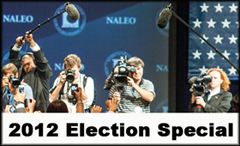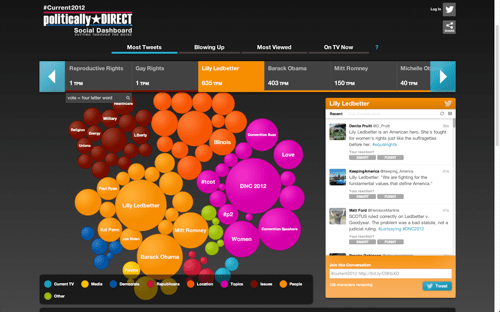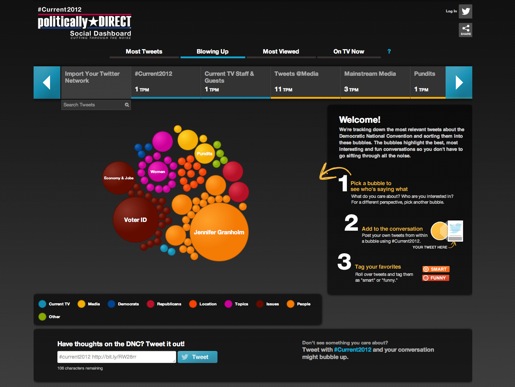In 2008, Current TV teamed up with Twitter to display user tweets live on-air during the presidential and vice presidential debates. It was quite an experiment combining live television and user commentary/feedback — but it was very early. Few people had heard of Twitter, and fewer television entities recognized the power of real-time feedback to fuel on-air experiences.
In the four years that followed, the social media landscape would explode, the original “Hack the Debate” leaders would move onto Twitter where they built from scratch a new media business, and Current TV itself would transform into an all-new cable news network focused on political commentary and news analysis.

Fast forward to 2012.
For this year’s presidential election, Current wanted to leverage early success bringing users into the national conversation and on-air presentation, but amplify the experience, given both Current’s goals as a TV network, and the exponential growth of the Twitterverse. We wanted to create a multi-screen experience that showcased a wide range of the most substantive tweets in real time and in sync with the topics of the events at hand and commentary on television. And so we created the Politically Direct Social Dashboard.

The Politically Direct Social Dashboard, seen above, allows users to participate in and influence online and on-air coverage. Users can tag or react to tweets, or dive into particular issues that matter to them. The online experience displays volume and velocity of tweet sentiment from the entire, filtered Twitter firehouse through “bubbles” that expand and contract. Users can join in by signing in through Current.com or their own social network, providing the added benefit of social tie-in with outside social media.
Our network president, David Bohrman, formerly the chief innovation officer of CNN, challenged us to come up with a more innovative way for the website to partner with television, with real-time content collaboration and display across all platforms. Fortunately, we had built a fully integrated team in the time since I arrived at Current, and had not only brilliant engineers, but a new digital product, editorial, design and production staff who lived and breathed social media.
On television, Bohrman envisioned devoting an unprecedented amount of screen space to what was going on in the social sphere, as seen here:
The digital team powered the data for that television experience, and also built a user-facing platform for our most engaged users.
An in-screen video capturing what the user experience was like during the conventions can be seen here.
The Process
The dashboard was built in-house by our engineers on Ruby on Rails, and uses the D3 JavaScript library. Twitter Firehose integration was provided through Mass Relevance. The dashboard was developed using a rapid agile methodology, allowing us to use metrics and user feedback to immediately inform improvements with each release. On-air integration was done real-time through API calls and feeds to VizRT in the television master control room. After each event, our editorial team partnered with Crimson Hexagon to provide post-event analysis of the social conversation.
Behind the scenes
The Social Dashboard and television experience required enormous amounts of human moderation, as seen here in our “war room” of tweet moderation.
We worked with Mass Relevance tools to gain access to the Twitter firehouse and filter for profanity, nudity, swears, etc. But a human filter was also necessary to handle the wide variety of editorial questions requiring nuance and judgment. It was important not only that tweets were “safe” for TV, but also that they were relevant, integrated with actual election events, and that the overall flow provided an accurate snapshot of sentiment, and added value to the experience. For the conventions we cast a broad net looking to capture general “vox-pop” sentiment around each speaker. For the debates, we continued with audience sentiment, but focused on more substantive commentary, particularly fact-checking and “spin” analysis from audiences and experts alike. Current TV commentators, including co-founder Vice President Al Gore, participated both on-air and off, referencing the effort during the broadcast and live-tweeting their own original running observations and remarks.
The entire Current TV staff participated in the cross-platform moderation during each night of the RNC and the DNC and all four debates. This required enormous cooperation among all staff — a side benefit of which was increased cross-departmental staff collaboration, enthusiasm, and understanding of social media and digital. There’s no better explainer of the power of social media than teaching your finance folks how to moderate tweets!
Themes and Memes, Oh My
Since we wanted the social conversation to keep up with the ebb and flow of real-time discussions, we had to create hundreds of “buckets” of possible Twitter conversations — everything from topic: “Obama” to “#horsesandbayonets” to “swing state ohio,” the “economy,” or “abortion.” This required daily research, some of which we conducted using the PBS Newshour’s excellent daily briefs on big questions. Our questions included: How to frame the issues? What were the key words likely to be used? Who in the blogosphere or mainstream media did we think would be tweeting material of value? Who were the operatives from each campaign? It also required on-the-fly adjustments as new themes and memes emerged, be it “emptychair” “#cantafford4more” or “lyinryan” or recognition of the latest “binder” meme on tumblr.
On the night of the second debate, our production team in Los Angeles camped out in a chat room with our New York and San Francisco staffs where they announced and analyzed the latest trends on twitter, assisting with our “bucket tracking.” On occasion, the web producer in L.A. appeared on-air to break down the various themes and memes of the night.
The pace of the night was ferocious. As readers of MediaShift likely know, the second debate garnered more than 12 million social mentions on Twitter, making it the third most social event of all time (ahead of Super Bowl XLVI). It would have been easy to simply display conversation around the #Current2012 hashtag, but we did not want to do a simple “call and respond” or have an insular conversation; we wanted to reach out to Twitter and bring that energy (and those eyeballs) to our analysis.
Real-time keyword adjustments were necessary at all times. Fortunately, we have a whip-smart group of digital product folks who thought through every angle and solved each problem as it came up. A debate bucket titled “zingers,” for example, had to be tuned to exclude the popular sweet treat. A bucket set up for Nancy Pelosi’s speech during the DNC had to be carefully modulated not to show tweets from people buying new “houses” vs. talking about the “house” leader. Try creating a conversation around “energy” and climate change, without capturing widespread sentiment about Obama’s “lack of energy” onstage during the first presidential debate.
Results
Aside from the inherent value in building a new experience for our audience, this approach provided multiple cross-promotional benefits.
The on-air screen experience was fresh, relevant and differentiated from other, more traditional, TV networks. We believe that Current TV was the first network, for example, to discover the “@InvisibleObama” trend on Twitter and recognize it on-air. The social nature of the project created viral amplification for Current’s #Current2012 coverage. And the interactive experience allowed us to find and reach new audiences through the two-way feedback cycle of social.
We saw an increase in mobile and iPad traffic to our Dashboard experience — along with the lift in television ratings and younger skewing audiences on all platforms — as more and more users participated in the experience as a “Second Screen” companion to their television consumption. We believe this high level of engagement and passionate consumer behavior offers particular possibilities for future advertising and brand opportunities.
A few specifics:
- The two-screen experience led to a 7x increase in engagement, 15 minutes’ time on site for tablet users.
- Raw traffic to Current.com rose by 15%.
- Average time on the Politically Direct Social Dashboard — which represents an all-important measure of engagement for advertisers — soared. It grew from 5:43 to over 20 minutes.
- Current’s Twitter referral traffic jumped 10x.
- Buzz and engagement: During the second presidential debate, Current came in No. 4 among all television programs as the “most social TV network,” beating out many bigger News competitors, including CBS and PBS.
Lessons Learned
There were many lessons learned along the way. Due to the high volume of Twitter traffic, at one point our Twitter firehose was up to 14 minutes delayed. That may not sound like much — but it’s everything in the real-time experience of the events at hand. For future events, we are creating an in-house backup solution that involves Current hosting and handling itself.
TV integration and control room communication was complicated, requiring constant refinement and team debriefing, particularly in the live environment. Digital staff had to learn the language of a live control room and how to talk on headset for maximum impact with multi-tasking television staffs, and television staffs had to adjust and add this all-new element to their on-air decision-making.
A core part of the ongoing strategy was focusing on mobile. A short runway to launch meant going live with a minimally viable product. As we progressed, we constantly iterated and updated. We optimized for mobile with a streamlined design and slightly altered interaction details, leading to a jump in mobile and tablet users.
With an agile process, we launched updated versions of the site weekly. It was a grueling pace, but as the product and user experience folks tell it, “each launch is an opportunity to refine/iterate/improve.” The team analyzed both metrics and user feedback at every stage, and the engineers simplified the user experience while adding functions: e.g., more robust user tagging, historical events, exposing share. Likewise, on-air, between the conventions and the debates, the TV team refined the visual presentation of tweets on TV, again informed by data and user feedback. Social was not only core to the multi-platform experience, data from social media platform partner Crimson Hexagon helped us better understand our audience and their needs.
While a source of pressure, the team says that the very pace of the election events helped them focus and “get the key stuff out first,” iterating along the way.
Tips and Take-Aways
Two-way conversation takes work
At one point, a user posted to our site and suggested that we display on the air the dates of upcoming debates, in the graphics box to the right of the live video. We relayed that to the control room, made the change, and emailed the user. He/she was thrilled. But that was just one example. There were instances where users with high expectations for involvement had more ideas than we could incorporate.
Awareness through ambassadors
One next step is to figure out how to reach and involve influencers who can draw audiences to this new and different kind of coverage. We benefited from an unsolicited boost from celebrities like Alyssa Milano, who retweeted our real-time fact checking, and Eva Marcille of “America’s Top Model” fame, who Instagram’d our on-air experience. Without the benefit of paid advertising, we’ll need to interact on a daily basis with more ambassadors who are willing to engage their audiences in political conversation.
Experiment, learn, but plan for sustainability
While we are very happy with this experiment, we know the “all-hands-on-deck mentality” can’t last forever. We want to innovate in ways that keep pace with the changing media landscape and audience expectations, but we must find a way to regularly scale and sustain these activities.
Don’t forget to have fun!
There were many funny learning moments. We had to develop our own nerdy Star Trek-like language for tweet moderation [“TPM” = tweets per minute; “runway” = amount and quality of tweets available for a particular topic to display on-air, etc] and adjust as we went along. Bohrman gave us the leeway to make mistakes and adjustments as we went, and he encouraged and inspired experimentation. We created a “SWAT” team on the floor to improve the quality and speed of content. At times, one moderator might be manning a bucket with more than 3,000 tweets per minute. Now that’s rapid eye movement.
Nobody knows what the future holds
One of our engineers was wearing a T-shirt recently with a quote from Current TV’s early days: “The only way to know the future is to invent it.” That’s a bit over-the-top for me. But it does speak to the notion that we never know what will become the norm. In our unfortunately polarized political discourse, people are increasingly expecting to be able to talk back and among themselves about what is covered. The second screen experience with the ability to watch and talk with our friends and foes while watching TV (be it Grammys, Super Bowl, or Debates) is already on its way to becoming an expected part of the content consumption experience.
Angela Morgenstern is Senior Vice President, Digital for Current Media, where she leads a cross-functional team in defining and executing on Current’s digital content and product strategy and operations in order to grow audience, awareness, engagement, and revenue. Prior to that, she served as Senior Director, PBS Interactive, where she oversaw content across digital platforms, with a focus on original content that helped attract new audiences. Morgenstern came to PBS from MTV in New York. As Supervising Producer for MTV News, she managed thrice-daily original broadband coverage of news, music and movies, and worked on major multi-platform events like the MTV Movie Awards and Video Music Awards. Morgenstern’s background spans both television and the Web. She worked in documentaries and as a television producer and reporter at San Francisco-based public television station, KQED, and on numerous web products and sites. In 2001, Morgenstern launched the critically-acclaimed PBS FRONTLINE/World site, collaborating with FRONTLINE producers to showcase ground-breaking, global multimedia stories. She tweets from @angelamedia



